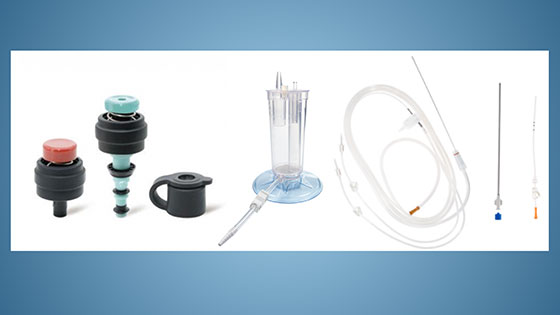Single-Use Surgical Products
Why Single-Use Surgical Products Are the Inevitable Future – and the Real Risks of Reuse
At UpViser, we know that patient safety and hospital efficiency are not opposing concepts, but rather two sides of the same coin. Our experience in areas such as Plastic and Reconstructive Surgery, Gastrostomy, Digestive Endoscopy, Lipedema Treatment, Regenerative Medicine, and Emergency Solutions proves every day that the choice of material can make the difference between a safe procedure and a risky one.

More and more hospitals and health authorities are turning to single-use surgical devices. This is not a passing trend, but a profound shift that responds to a clear need: ensuring that every intervention begins with new, sterile, reliable material that is immediately available. In addition to providing safety and confidence, in many cases single-use devices help reduce costs associated with reprocessing, eliminating the need for complex cleaning cycles, high energy consumption, and the use of harsh chemicals. The result is a system that is more agile, sustainable, and efficient, both for patients and healthcare institutions.
Risks of Reusing Single-Use Devices
It is widely demonstrated that single-use surgical products are safer in hospital environments. Although isolated cases exist of professionals attempting to sterilize and reuse these devices to save costs, such practices are rare, as most doctors and nurses are fully aware of the risks to patients.
The dangers include:
- Microcracks that compromise the integrity of the device.
- Biofilms and biological residues that facilitate the transmission of resistant pathogens.
- Cross-contamination between patients.
- Local or inflammatory complications.
- Legal risk, since any attempt at reprocessing makes the hospital or third party legally responsible for the product, with obligations for clinical trials, CE marking, and traceability.
Fortunately, the use of these practices is very limited, and the global trend is moving towards the adoption of single-use devices. This movement is driven by regulations such as the European Medical Device Regulation (MDR) and Spain’s Royal Decree 192/2023, which aim to reduce mechanical failures, hospital-acquired infections, and legal risks, consolidating a practice that protects both patients and healthcare personnel worldwide. Recent studies show that the risk of infection is significantly lower with single-use devices compared to reprocessed ones (ECRI Institute, 2022).
Everyday Stories in Hospitals
Let us imagine Laura, a nurse in an ICU, who must intubate a critical patient. She chooses a sterile, sealed tube, ready to use. At that moment there is no room for doubt or second chances: absolute safety is the only option.
Single-use devices not only protect the patient, they also reduce pressure on healthcare teams and ensure that every step is carried out with confidence.
Safety, Efficiency, and Responsible Sustainability
Manufacturing and disposing of medical products does have an environmental cost. However, every hospital infection prevented means fewer antibiotics, fewer days of hospitalization, and less final waste. According to the European Centre for Disease Prevention and Control (ECDC), Spain has rates of MRSA and resistant Enterobacteriaceae above the European average. To reduce infections, increase staff confidence, and improve patient safety, the Spanish healthcare system is increasingly turning towards single-use products.
Time and Cost: Two Factors That Cannot Be Ignored
Beyond clinical safety, single-use surgical products offer clear advantages in time and cost. Every reprocessing cycle for a reusable instrument requires:
- Collection and transport of the used material
- Mechanical and manual cleaning
- Sterilization
- Quality control and traceability
- Specialized personnel
This process consumes hours of work, energy, and resources, and still never fully eliminates the risk of failure or contamination.
A simple example: if sterilizing and reprocessing a device costs between €25 and €40 per cycle (adding personnel, equipment, energy, and internal logistics), and that instrument is reused only a few times before being damaged, the total cost can easily exceed that of a new disposable product, which arrives sterile, sealed, and ready to use for €15 to €20.
In addition, using single-use products saves time for nursing and sterilization staff, allowing them to focus on direct patient care rather than repetitive reprocessing tasks. In large hospitals, this can mean hundreds of hours freed each month and a significant reduction in indirect costs.
Conclusion
Modern medicine requires a balance of safety, cost, and sustainability. Choosing high-quality single-use surgical products reduces risks, protects both patients and staff, and ensures compliance with regulations.
At UpViser, we work hand in hand with surgeons and hospitals across Spain to provide sterile, certified, and ready-to-use devices, supported by a specialized team for each medical field.
Discover UpViser’s Solutions for Your Clinic or Hospital
We offer a catalog of single-use surgical products and specialized medical solutions in:
- Plastic and Reconstructive Surgery
- Gastrostomy
- Digestive Endoscopy
- Lipedema Treatment
- Regenerative Medicine
- Emergency Solutions
Our devices provide safety, efficiency, and confidence in every procedure.
Contact UpViser and discover which single-use products best suit your work, clinic, or hospital.
Newsletter
Be up to date. Subscribe to our newsletter. The newsletter is sent once a month and can be canceled at any time.
| Español | |
| Responsable | UpViser Spain SL |
| Finalidad | Responder a las solicitudes y/o compras formuladas por teléfono, email, a través del formulario de la página web "upviser.es". Incluir sus datos en nuestra agenda de contacto, planificar y concretar citas, así como para suscribirse a nuestro newsletter. |
| Legitimación | Consentimiento del interesado |
| Destinatarios | Entidades colaboradoras para fines administrativos y para la ejecución de su solicitud. |
| Derechos | Tiene derecho a acceder, rectificar y suprimir los datos, así como otros derechos, como se explica en la información adicional. |
| Información adicional | Puede consultar la información adicional y detallada sobre Protección de Datos aquí. |